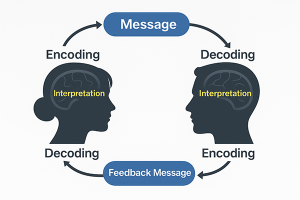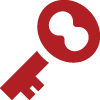1.3: The Communication Process
Learning Objective
 9. Illustrate the communication process to explain the end goal of communication.
9. Illustrate the communication process to explain the end goal of communication.
When you strip it down to its bare essentials, the whole point of communication is to move an idea in your head into someone else’s so they understand that idea the same way you do. If there is work to be done to ensure that the person receiving your message understands your intended meaning, the responsibility falls mainly on you, the sender. However, the receiver also has responsibilities, especially putting themselves in a position to understand the message and confirm their understanding of it, which makes communication a dynamic, cyclical process.
Breaking down the communication cycle into its component parts is helpful to understand your responsibilities as both a sender and receiver of messages, as well as to troubleshoot communication problems. First, let’s appreciate how amazing it is that you can form an idea as an incredibly complicated pattern of electrical impulses in your brain and plant an almost-identical pattern of impulses in someone else’s brain very easily. The process may be complicated, but you are wired to do this every second of the day. Though various models of communication help us understand this process, let’s look at a relatively popular and straightforward one that will help us diagnose communication breakdowns in the next section.

To simplify the Osgood-Schramm model of communication (Osgood & Sebeok, 1954; Schramm & Roberts, 1971), you first encode an idea into a message when you want to communicate that idea with the outside world as the sender. If you choose to send that message in the channel of in-person speech (as opposed to other spoken, written, or visual channels, examples of which are listed in Table 1.3 below), you first encode your idea into the language in which you will be understood, which your brain does automatically for you. Your brain then sends electrical impulses to your lungs to push air up past your vocal cords, as well as electrical motor impulses to vibrate your vocal cords and bend the air into sound waves, as well as shape those waves further with your jaw, tongue, and lips. Those sound waves ripple through the air amidst competing noise till it reaches the eardrum of the receiver. Continuing like a Rube Goldberg machine, the eardrum rattles a trio of tiny bones, the vibrations of which tickle the cochlear hairs of the inner ear, which send patterned electrical impulses into the receiver’s brain. Finally, that brain automatically decodes those impulses into the same pattern of electrical impulses that formed the original idea you had in your brain. Simple, right?
Table 1.3: Examples of Communication Channels
| Verbal | Written | Visual |
|---|---|---|
| In-person speech | Body language (e.g., eye contact, hand gestures) | |
| Phone conversation | Text, instant message | Paintings, drawings, symbols, logos |
| Voice-over-internet protocol (VoIP) | Report, article, essay | Graphs, graphic designs |
| Voicemail message | Tweet/post | Photographs |
| Intercom | Letter | Architecture |
| Podcast | Memo | Semaphore |
| Radio | Blog | Font types |
To ensure that the message was decoded properly and understood, the receiver then encodes and sends an intentional or unintentional feedback message that the first sender receives and decodes. This second stage of the model effectively flips the roles so that the original receiver becomes the sender and the initial sender becomes the receiver. When the initial sender understands from the feedback message that the receiver understood the first message, then the goal of the communication process has been achieved. If you state, for instance, “I’m hungry” and the receiver of that message responds by saying, “Me too. Let’s get a taco,” you can accurately infer that they understood your intended meaning without them stating explicitly, “I understand.” From there, messages and feedback continue to cycle around in a dynamic, back-and-forth conversation that exchanges new ideas and offers opportunities for the receiver of those messages to ask for clarification if understanding isn’t achieved as intended.
Now, the receiver’s intentional or unintentional feedback message need not be in the same channel as the sender’s. If the receiver of the above “I’m hungry” message nods and holds up a cookie for you to take rather than say anything, it would be clearly implied from their intentional nonverbal gesture that they correctly decoded and understood your meaning: that you’re not only hungry, but also that your hunger would be somewhat relieved by the cookie. If the receiver responds in no other way than with a loudly rumbling stomach, their unintentional nonverbal feedback also confirms their understanding of the message.
(Jones, 2020)
As you can see, this whole process is easier done than said because you encode incredible masses of data to transmit to others all day long in multiple channels, often at once. You are likewise bombarded with a constant multi-channel stream of information in each of your five senses that you decode without even being consciously aware of this complex process. You just do it. Even when you merely talk to someone in person, you’re communicating not only through the words you’re voicing but also through your tone of voice, volume, rate of speech (e.g., fast or slow), facial expressions, eye contact, posture, hand and body movements, style of dress, etc. All such channels convey information besides the words themselves, which, if they were extracted into a transcript of words on a page or screen, communicate relatively little compared with the multi-channel sensory barrage you emit intentionally and unintentionally. In professional situations, especially in important ones such as job interviews or meetings with clients where your success depends entirely on how well you communicate across the verbal and all the nonverbal channels, it’s extremely important that you be in complete control of as many of them as possible and present yourself as a detail-oriented pro—i.e., a professional employers can trust to get the job done perfectly for their money.
Key Takeaway
 The goal of communication, as a cyclical exchange of messages, is to ensure that you’ve moved an idea in your head into someone else’s so that they understand it as you intended.
The goal of communication, as a cyclical exchange of messages, is to ensure that you’ve moved an idea in your head into someone else’s so that they understand it as you intended.
Exercises
 1. Without looking at the communication process model above, illustrate your own theory of how communication works and label the diagram’s parts. Compare it to the model above and discuss the advantages and disadvantages of each.
1. Without looking at the communication process model above, illustrate your own theory of how communication works and label the diagram’s parts. Compare it to the model above and discuss the advantages and disadvantages of each.
2. Table 1.3 above compiles only a partial list of channels for verbal, written, and visual channels. Extend that list as far as you can push it.
References
Jones, M. (2020, February 3). Schramm’s Communication Model [Video]. YouTube. https://www.youtube.com/watch?v=nh1_Z36sIMQ
OpenAI. (2025). ChatGPT (May 14 version) [Large language model]. https://chatgpt.com/
Osgood, C. E., & Sebeok, T. A. (1954). Psycholinguistics: A Survey of Theory and Research Problems. https://pure.mpg.de/rest/items/item_2368338_3/component/file_2368337/content
Schramm, W. L., & Roberts, D. F. (1971). The Process and effects of mass communication. U of Illinois P. (Original work published 1954) https://archive.org/details/processeffectso00wilb

